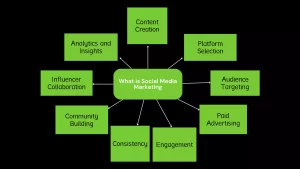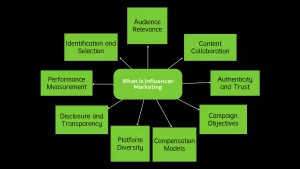Difference between Social Media Marketing and Influencer Marketing
Two distinct strategies, Social Media Marketing, and Influencer Marketing, stand out as powerful approaches to engage audiences and promote brands. While both leverage the reach of social platforms, they diverge in their core principles and execution.
Understanding the nuances between these strategies is essential for designing effective campaigns that resonate with modern consumers.
A comprehensive digital marketing strategy that makes use of a variety of social media channels to engage customers, reach target markets, and achieve specific marketing objectives is social media marketing.
To have a solid online presence and cultivate deep connections entails generating, sharing, promoting content and engaging with followers.

Key aspects of social media marketing include:
- Content Creation: Crafting compelling and relevant content is at the core of social media marketing.Text postings, pictures, videos, infographics, and other media are all examples of such content. The objective is to connect with what is on the minds of the audience.
- Platform Selection: Choosing the right social media platforms is crucial. Different platforms attract distinct demographics and cater to various content formats. For instance, Instagram is image-centric, while Twitter focuses on concise text updates.
- Audience Targeting: Defining and understanding the target audience is essential. Social media platforms offer tools to narrow down demographics, interests, behaviours, and locations, enabling marketers to tailor content to specific groups.
- Engagement: Interaction with the audience is a key element. Responding to comments, messages, and mentions humanises the brand and strengthens relationships. Engagement can involve discussions, answering questions, and acknowledging feedback.
- Paid Advertising: Social media platforms offer advertising options that allow businesses to promote content to a broader audience. Paid ads can be highly targeted, maximising their effectiveness.
- Influencer Collaboration: Partnering with influencers—individuals with a large and engaged following—can expand a brand’s reach and credibility. Influencers can create sponsored content or reviews to endorse products or services.
- Analytics and Insights: Tracking performance metrics is crucial to measuring the effectiveness of social media efforts. Metrics include engagement rates, reach, impressions, click-through rates, and conversions.
- Consistency: Consistent posting is important to maintain an active online presence. Regular updates keep the audience engaged and informed.
- Brand Personality: Developing a consistent brand voice and personality across social media channels helps create a cohesive and recognizable identity.
- Community Building: Social media provides an avenue to build a community around a brand. This involves fostering a sense of belonging, encouraging user-generated content, and hosting discussions or events.
- Campaigns and Contests: Running social media campaigns, giveaways, and contests can attract attention and encourage user participation, leading to increased visibility.
- Adaptation and Innovation: The social media landscape is ever-evolving. Staying up-to-date with trends, new features, and changing user behaviours is crucial for effective social media marketing.
Also read: How to use social media for small business?
What Is Influencer Marketing?
In order to promote goods, services, companies, or campaigns, influencer marketing is working with people who have a sizable and active online following, often known as influencers.
Connect with potential customers in a more genuine and relatable way, this sort of marketing makes use of the influencer’s credibility, authority, and relationship with their audience.

Key components of influencer marketing include:
- Identification and Selection: The process begins with identifying influencers who align with the brand’s target audience, values, and niche. These influencers include bloggers, vloggers, social media personalities, experts, celebrities, or micro-influencers with smaller, engaged followings.
- Audience Relevance: An influencer’s audience should closely match the brand’s target demographic. The influencer’s content’s authenticity and their followers’ relevance contribute to the campaign’s success.
- Content Collaboration: Brands collaborate with influencers to create content seamlessly integrating the product or service. This content can take various forms, such as product reviews, tutorials, unboxings, behind-the-scenes looks, or lifestyle posts.
- Authenticity and Trust: Influencers are trusted by their followers due to their genuine and relatable content. When influencers endorse a product, it comes across as a personal recommendation, building trust and credibility.
- Campaign Objectives: Campaigns using influencers might aim to accomplish a variety of things, including raising brand awareness, boosting sales, introducing new products, promoting events, or fostering user-generated content.
- Compensation Models: Influencers may get a variety of forms of payment, such as cash, gifts, commissions from affiliated businesses, or a mix of these. Compensation is often based on factors like the influencer’s reach and engagement rates.
- Disclosure and Transparency: Ethical influencer marketing involves clear disclosure when content is sponsored. This transparency ensures that the audience is aware of the commercial relationship.
- Performance Measurement: Brands measure the success of influencer campaigns using metrics like engagement rates, reach, clicks, conversions, and return on investment (ROI).
- Long-term Relationships: Some brands opt for ongoing relationships with influencers rather than one-off campaigns. Long-term collaborations can deepen the influencer’s connection with the brand and its audience.
- Platform Diversity: Influencers can be active on various platforms, including Instagram, YouTube, TikTok, blogs, and podcasts. Brands choose platforms based on their target audience’s preferences.
- Micro-Influencers: These are influencers with smaller but highly engaged followings. Micro-influencers often have a stronger connection with their audience and can offer niche-specific influence.
Difference between Social Media Marketing and Influencer Marketing
Here is the difference Social Media Marketing and Influencer Marketing
| Aspect | Social Media Marketing | Influencer Marketing |
|---|---|---|
| Nature and Focus | Brand engages directly with the audience. | Collaborating with influencers to reach an audience. |
| Source of Promotion | Brand creates and distributes content | Influencer creates content with brand integration |
| Credibility Trust | Builds brand credibility over time. | Leverage’s influencer’s established trust. |
| Content Creation | Brands create content aligned with messaging | Influencers create content within their style |
| Audience Reach | Relies on the brand’s social media following. | Accesses influencer’s engaged and targeted audience. |
| Control | Brands have full control over the brand. | Influencers have creative freedom within guidelines. |
| Goals | Brand awareness, engagement and generation. | Promoting products, services, or campaigns |
| Relationship Dynamics | Brand-to-audience interactions | Influencers-to-audience endorsement |
| Personalisation | Limited personalisation | Personalised and relatable content for the influencer’s audience. |
| Trust Building | Builds trust over time. | Leverages influencer existing trust with audience |
| Audience Diversity | Appeals wider audience | Targets an audience of a niche |
| CTA | Direct CTA and links for conversions | Influencers guide audience to brand action |
| Role in Strategy | Integral part. | Based on the need and segment |
Conclusion
Social Media Marketing and Influencer Marketing shine as two distinct yet interlinked strategies. While Social Media Marketing empowers brands to directly engage and connect with their audience, Influencer Marketing harnesses the authenticity and reach of influencers to create impactful endorsements.
Businesses can forge meaningful connections, enhance credibility, and amplify brand resonance by seamlessly integrating both approaches. To win over the market with this fusion of strategies and unlock the full potential of your campaigns, reach out to us at hello[at]noboruworld.com.
FAQ
What is the main difference between Social Media Marketing and Influencer Marketing?
By creating content, interacting with users, and running paid adverts on social media platforms, brands may communicate directly with their audience through social media marketing.
Influencer marketing involves collaborating with people (influencers) who have a sizeable fan base to honestly advertise goods, services, or businesses to their audience.
How do I choose between Social Media Marketing and Influencer Marketing for my brand?
The best way to establish a direct online presence for your company, interact with your audience, and spread your message is through social media marketing.
But Influencer Marketing is ideal for leveraging an influencer’s credibility, tapping into their targeted audience, and benefitting from authentic endorsements.
Can Social Media Marketing and Influencer Marketing be used together?
Yes, they can complement each other. Combining both strategies allows brands to enhance engagement through their content and gain additional reach and authenticity through influencer endorsements.
What is the role of authenticity in both strategies?
TVideo content’s popularity stems from its engaging nature. Statistics reveal that video posts receive higher engagement and reach, making them a powerful tool for conveying messages and showcasing products.
What role do influencer marketing statistics play?
In Social Media Marketing brands must maintain an authentic brand voice and engage genuinely with their audience to build credibility. Influencer Marketing authenticity is central, as influencers’ genuine endorsements resonate strongly with their audience, enhancing trust and credibility.
Read More – What is influencer marketing: How to develop your strategy



